|
|

|
Porsche, and the Porsche crest are registered trademarks of Dr. Ing. h.c. F. Porsche AG.
This site is not affiliated with Porsche in any way. Its only purpose is to provide an online forum for car enthusiasts. All other trademarks are property of their respective owners. |
|
|
| nick mironov |
 May 6 2010, 12:32 PM May 6 2010, 12:32 PM
Post
#1
|
|
nickm   Group: Members Posts: 204 Joined: 12-June 05 From: San Francisco, CA Member No.: 4,264 |
My Renegade water pump failed yesterday. The pump impeller is stamped steel and the blades all just folded over or sheared off. I understand that the cast impellers are much stronger, but that not all manufacturer's cast models will fit into the Renegade housing. Anybody have experience with cast impeller pumps that will fit into the Renegade housing?
Since there is no bypass in the Renegade system, Renegade instructions are to limit the motor RPM to 3,000, or less, untill the thermostat opens. I have observed this, but the pump still failed after 5,500 miles. Renegade now makes a bypass kit, which I going to try, but I would still like to get a more durable pump. Nick |
  |
Replies
| nick mironov |
 May 26 2010, 10:00 AM May 26 2010, 10:00 AM
Post
#2
|
|
nickm   Group: Members Posts: 204 Joined: 12-June 05 From: San Francisco, CA Member No.: 4,264 |
This is the Test Setup.
Although the pump housing has two outlets, for convenience, I decided to use one for the pressure gauge and use the other for the output flow. If one were to test both outlets, I would not expect double the flow – maybe only 30% more. That would correspond well to the advertised pump rating of about 40 gpm at 4,000 RPM that I have seen. 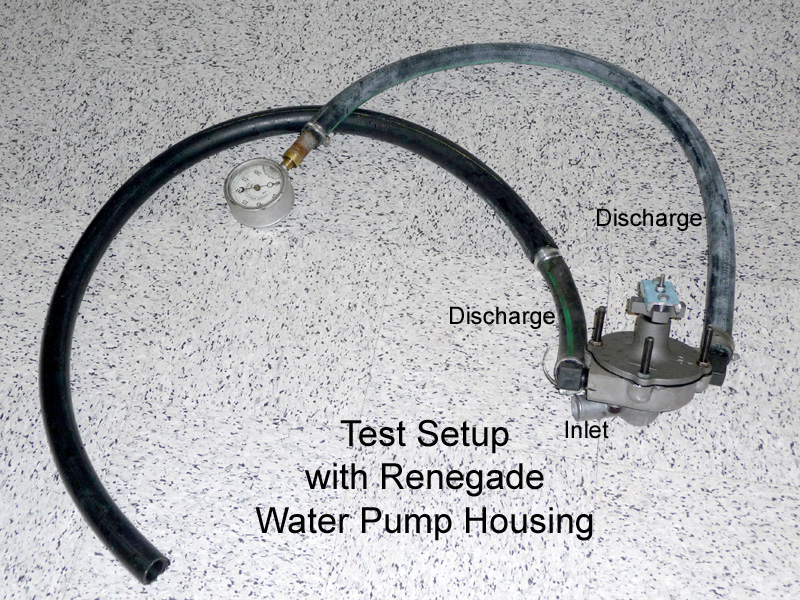 The motive force for spinning the pumps during testing was a 2,500 RPM hand-drill attached to the protruding bolt on the blue-colored channel that you see in the picture. Unfortunately, the drill could not achieve the full 2,500 RPM under load, so I had to settle for whatever it could do. As a result I had to calculate the resulting water pressures at higher RPMs. The calculated results (list image) do seem to correspond to real conditions, indicating very high pressures at dead head conditions - thermostat is closed during cold engine conditions and not having a bypass. Note that a nearly closed thermostat could be experienced under cruise conditions in very mild weather resulting in the same high pressure effect. Based on my experience and many other posts that I have read about failed pump impellers, the high pressure conditions do happen and that’s what results in catastrophic pump failures. The objective of this testing is to find a pump impeller that is more durable (able to withstand dead head pressures) and to possibly produce less pressure without sacrificing much water flow. Note that the Chrysler big block pumps were used on engines running at about 4,000 rpm, and in my case, my 283 SBC can run to over 6,000 rpm. |
| nick mironov |
 May 26 2010, 10:02 AM May 26 2010, 10:02 AM
Post
#3
|
|
nickm   Group: Members Posts: 204 Joined: 12-June 05 From: San Francisco, CA Member No.: 4,264 |
This is the Lineup of the Tested Impellers.
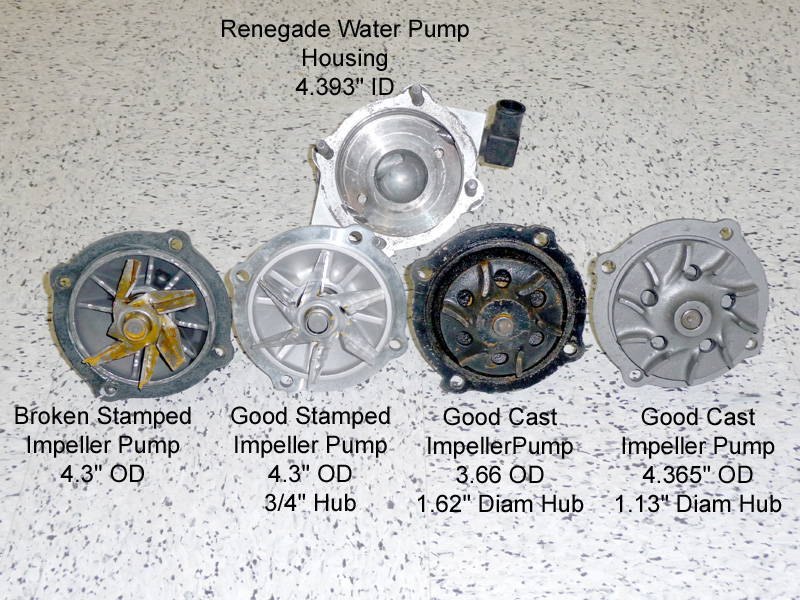 [ [The first one is my failed impeller. I decided to test it just for yucks. It is missing one blade and I un-bent the others so it would at least spin without hitting anything in the housing. It actually worked surprisingly well (except for the violent out-of-balance vibration). The second one is a brand new exact replacement stamped metal impeller with a 4.3” diameter (same as the damaged one). The third one is a cast iron impeller with a 3.66” diameter and 6 blades. SLITS provided this rebuilt one to me for testing. The fourth one is also cast iron impeller with a 4.365” diameter and 10 blades. SLITS also provided this rebuilt one to me for testing. Note that the 4.365” diameter is a tight fit into the 4.393: diameter housing. |
| nick mironov |
 May 26 2010, 10:04 AM May 26 2010, 10:04 AM
Post
#4
|
|
nickm   Group: Members Posts: 204 Joined: 12-June 05 From: San Francisco, CA Member No.: 4,264 |
Failed Stamped Impeller.
The impeller failed during simple city driving. I got about 5,000 miles out of it and never ran it about 3,000 RPM until the engine water temperature was above the thermostat 180 def F setting (per Renegade recommendations). The impeller failed anyway. I suspect that the blades bent a long time ago and finally one broke off, jamming the pump and leaving me stranded (not too far from home). 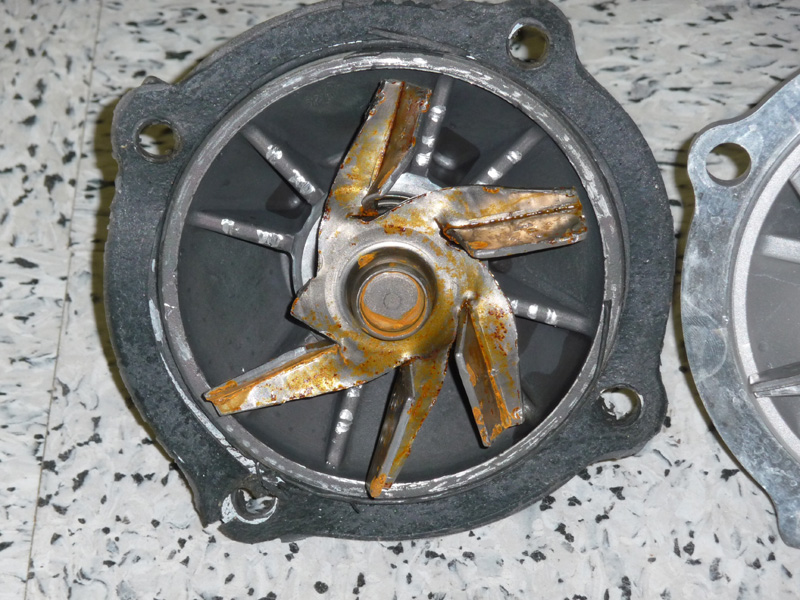 |
| nick mironov |
 May 26 2010, 10:05 AM May 26 2010, 10:05 AM
Post
#5
|
|
nickm   Group: Members Posts: 204 Joined: 12-June 05 From: San Francisco, CA Member No.: 4,264 |
Replacement Stamped Impeller
This is an exact replacement of the failed pump. It fits easily into the housing and has lots of tip clearance. Notice that it is already rusting at the stress points. 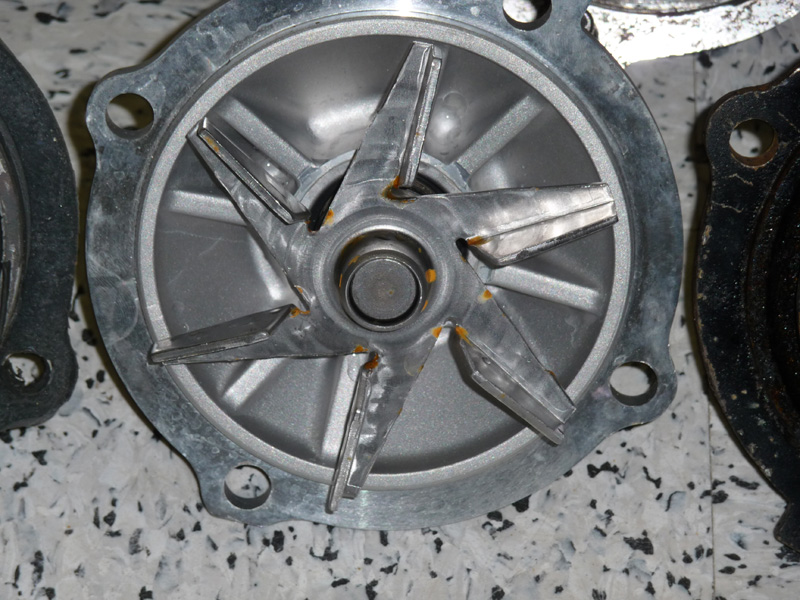 |
| nick mironov |
 May 26 2010, 10:06 AM May 26 2010, 10:06 AM
Post
#6
|
|
nickm   Group: Members Posts: 204 Joined: 12-June 05 From: San Francisco, CA Member No.: 4,264 |
3.66” Diameter Cast Impeller
This is the small diameter cast iron impeller that easily fits into the housing. SLITS says that this one is rated for engines with air conditioning. Odd that one would have a smaller impeller for that… Note the very large hub. The concern was that the large hub would block the housing water inlet and result in very poor flow conditions and/or cavitation. From other posts that I have read, people seemed to have observed this condition and decided to abandon using this impeller. I decided to test it. I was also concerned that the smaller diameter would result in too little flow during idle conditions. 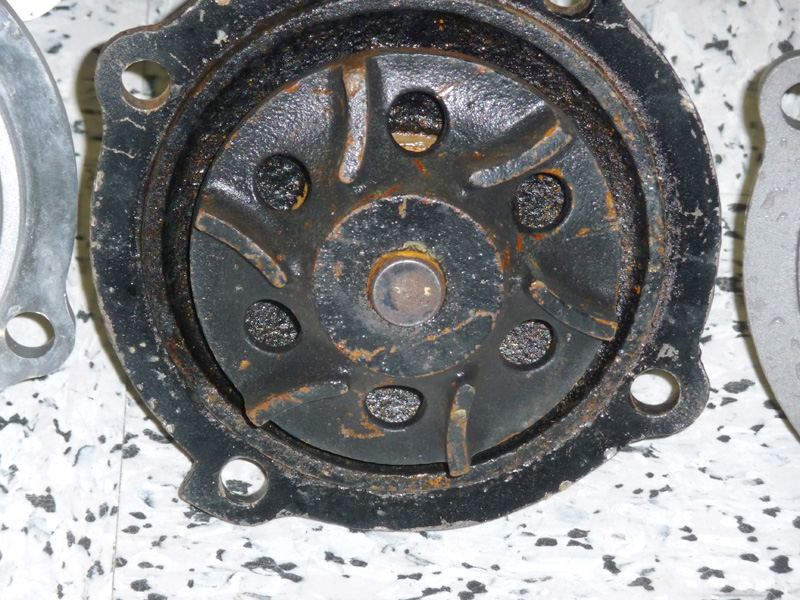 |
| nick mironov |
 May 26 2010, 10:07 AM May 26 2010, 10:07 AM
Post
#7
|
|
nickm   Group: Members Posts: 204 Joined: 12-June 05 From: San Francisco, CA Member No.: 4,264 |
4.365” Cast Impeller
I first thought that the impeller would not even fit into the housing. There was interference until I got it fully pressed in and bolted down. From other posts that I have read, people seemed to have tried to test-fit this kind of impeller (probably without fully installing it) and upon seeing the interference, also abandoned using it. 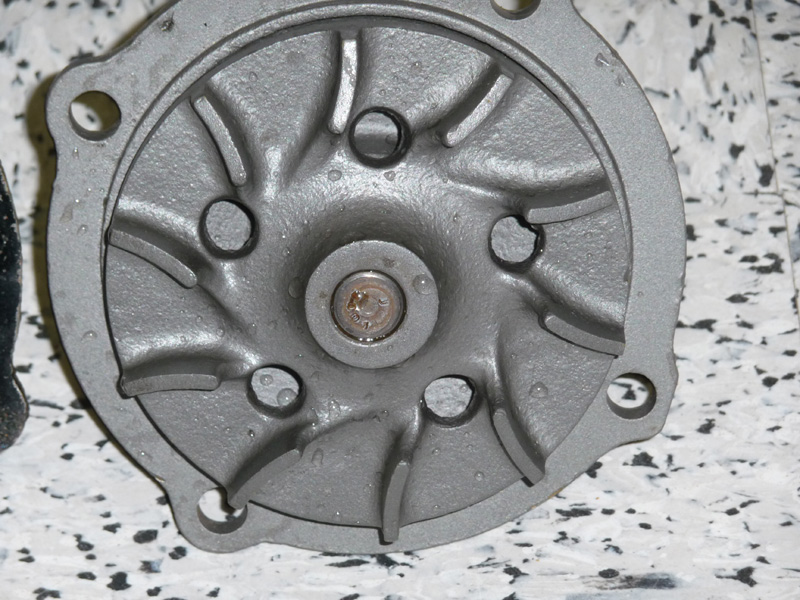 |
| nick mironov |
 May 26 2010, 10:08 AM May 26 2010, 10:08 AM
Post
#8
|
|
nickm   Group: Members Posts: 204 Joined: 12-June 05 From: San Francisco, CA Member No.: 4,264 |
The Housing
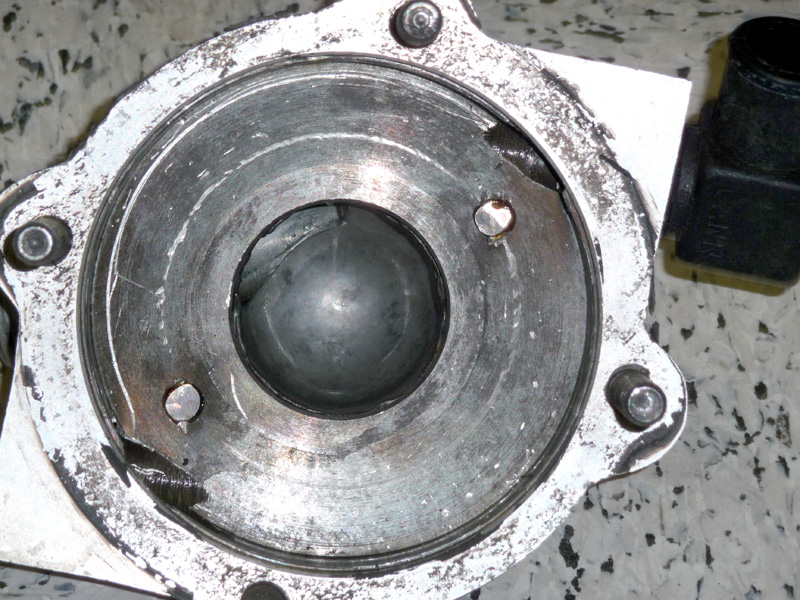 |
| nick mironov |
 May 26 2010, 10:09 AM May 26 2010, 10:09 AM
Post
#9
|
|
nickm   Group: Members Posts: 204 Joined: 12-June 05 From: San Francisco, CA Member No.: 4,264 |
Replacement Stamped Impeller in Housing
Note that there is lots of clearance at the housing inlet due to the open nature of this impeller. 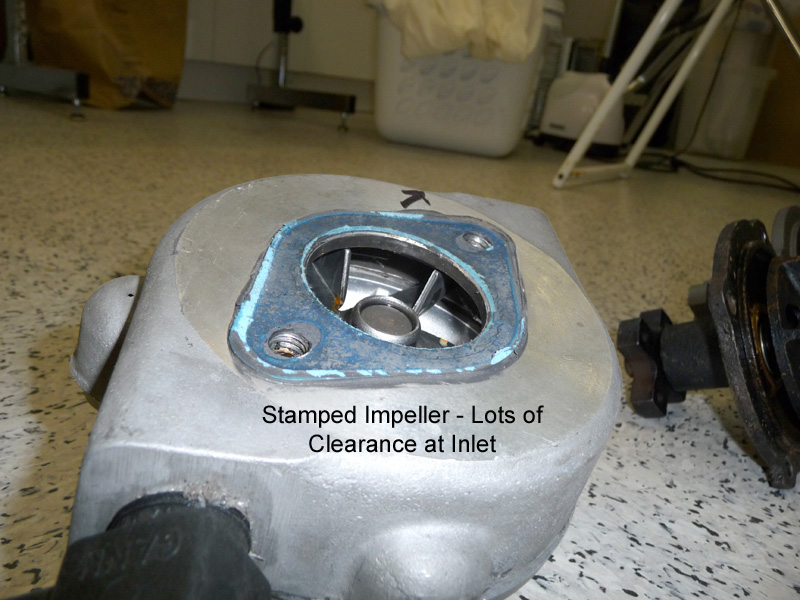 |
| nick mironov |
 May 26 2010, 10:10 AM May 26 2010, 10:10 AM
Post
#10
|
|
nickm   Group: Members Posts: 204 Joined: 12-June 05 From: San Francisco, CA Member No.: 4,264 |
4.365” Cast Impeller in Housing
There is also good clearance at the housing inlet due to the relatively small hub. 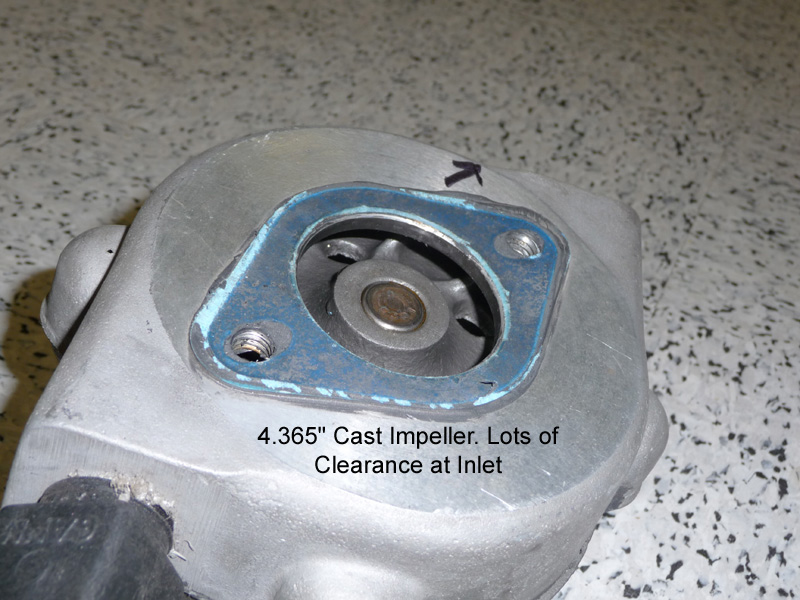 |
| nick mironov |
 May 26 2010, 10:11 AM May 26 2010, 10:11 AM
Post
#11
|
|
nickm   Group: Members Posts: 204 Joined: 12-June 05 From: San Francisco, CA Member No.: 4,264 |
4.365” Cast Impeller in Housing
Note that there is only 0.006” clearance between the bottom of the blade tip and the housing (measures with a feeler gauge inserted into one of the outlets). The clearance between the blade and the housing is also very small (can’t really see it in this picture). I would be very cautious about using this size impeller, because I would be concerned that any out of tolerance housing and/or impeller dimensions, bearing wear, etc. could lead to binding. 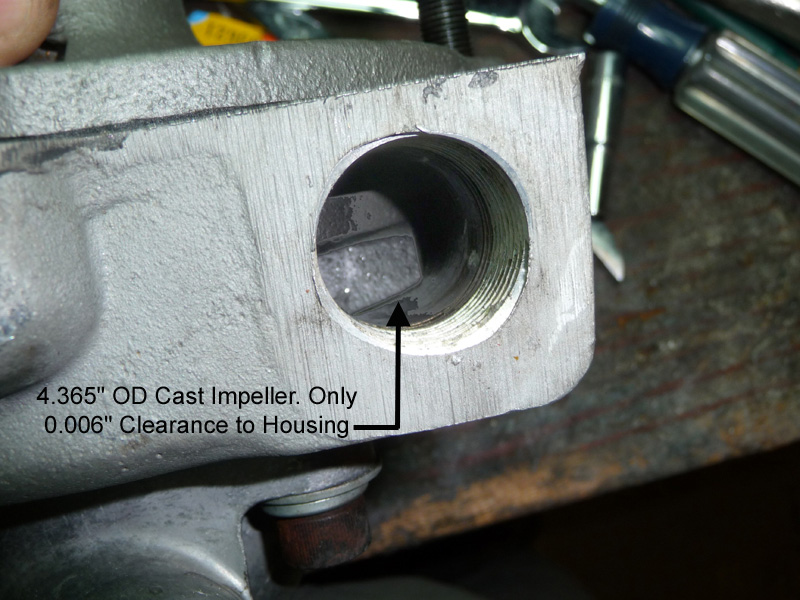 |
| nick mironov |
 May 26 2010, 10:12 AM May 26 2010, 10:12 AM
Post
#12
|
|
nickm   Group: Members Posts: 204 Joined: 12-June 05 From: San Francisco, CA Member No.: 4,264 |
3.66” Cast Impeller in Housing
Note the very small clearance the large hub produces at the housing inlet. I thought that this would be very restrictive and cause flow problems. I was very surprised that it did not and the test results were very good. 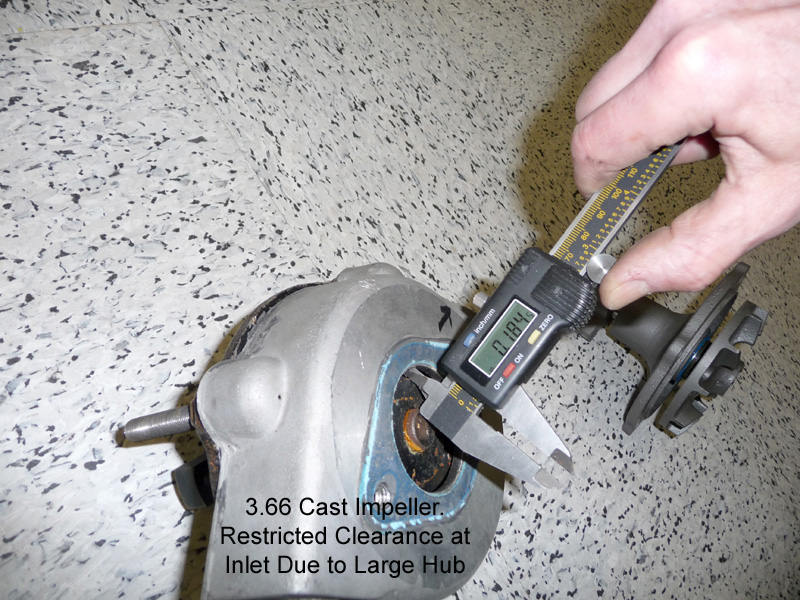 |
| nick mironov |
 May 26 2010, 10:13 AM May 26 2010, 10:13 AM
Post
#13
|
|
nickm   Group: Members Posts: 204 Joined: 12-June 05 From: San Francisco, CA Member No.: 4,264 |
Housing
After I finished testing everything, I cleaned up the housing by buffing out the nicks and burrs, caused by the impeller failure, and beveled the inlet to get better inlet conditions. 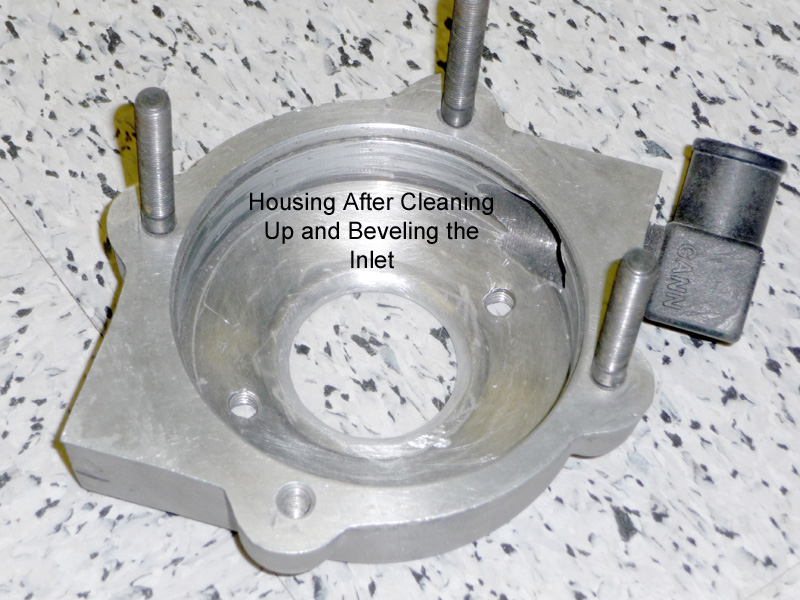 |
| nick mironov |
 May 26 2010, 10:14 AM May 26 2010, 10:14 AM
Post
#14
|
|
nickm   Group: Members Posts: 204 Joined: 12-June 05 From: San Francisco, CA Member No.: 4,264 |
3.66” Cast Impeller in Housing after Beveling the Inlet.
The clearance was increased and the resulting clearance of about 0.25”, while it seems very small, is more than the net free area of the sum of the two outlets. I did not retest the 3.66” impeller after I did this, since it worked so well before beveling. 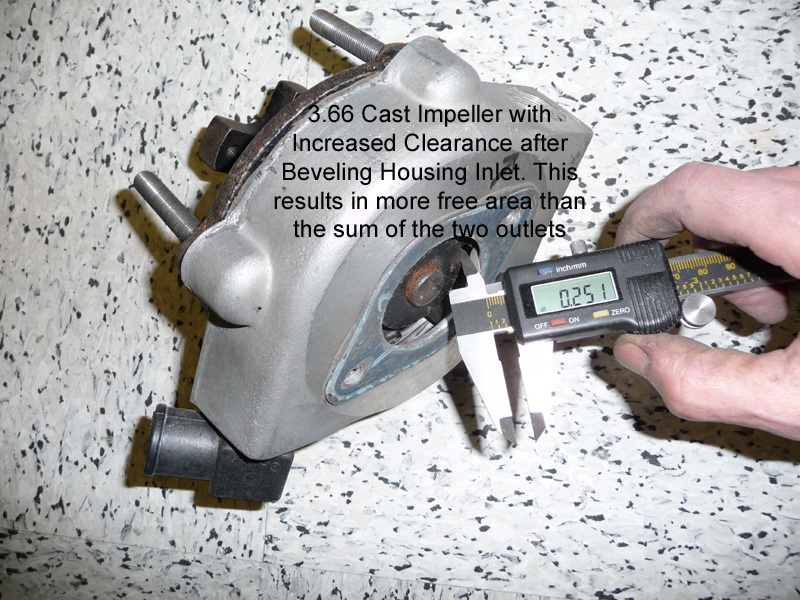 |
| nick mironov |
 May 26 2010, 10:16 AM May 26 2010, 10:16 AM
Post
#15
|
|
nickm   Group: Members Posts: 204 Joined: 12-June 05 From: San Francisco, CA Member No.: 4,264 |
The Results
Since I did not have test equipment to test the pumps at actual motor driven RPMs (idle through 6,000 RPM), I had to settle for low RPM tests and extrapolate out to the higher RPMs. The engine pulley and the pump pulley are the same size (they look the same, I didn’t actually measure them) so the pump RPM is the same as the engine RPM. Since I could not achieve actual performance data, I decided to test only one of the two pump outlets for convenience. I think that if both outlets were testes simultaneously, the flow would not be double, but only about 30% more. The results indicate relative (not absolute) performance of the pumps. See test data below. Broken Stamped Impeller This impeller, even though missing a blade and being mangled, performed surprisingly well (even though it was way out of balance). This means to me that one could have a badly damaged impeller with bent blades, and the pump would still work and one would never even know until a blade came off due to cyclic stressing. Replacement Stamped Impeller This produced the highest flows and pressures. However, highest flows and pressures are not necessarily what we want. We want to keep the pressures moderate so that we don’t burst the hoses or have the pump fail. Note that during dead head testing, the pressure was erratic and bouncing between 6 and 10 PSI. (The other pumps did not do this). This is suggesting to me that something like cavitation might be going on during dead heading. I suspect that this is what is causing the stamped pumps to fail. 3.66” Cast Impeller This pump had the lowest pressure at only slightly reduced flow (even before I beveled the housing inlet). The idle flow was the lowest of the group (as expected), but not as low as I thought it would be. I settled on this pump and also beveled the inlet for better water flow. I did not retest it after beveling the inlet. 4.365” Cast Impeller The tight tip clearance of this pump turned me off. Any small deviation could potentially cause it to bind up. It had good performance, better than the stamped impeller as far as pressure and flow. It was the best looking of (except that the hub appears to be out of round, but did not cause any noticeable vibration). Other Information I decided to install bypass anyway, to a keep the dead head pressures down. Renegade is starting to market a bypass system and I decided to try it. It is very simple. You remove the regular thermostat and install an external Wahler bypass thermostat, connect the discharge to the filler pot (as usual) and run the bypass back to the pump inlet and make the connection with a Tee fitting (pictures later). The Wahler thermostat is for a BMW 2002 or 320i. (W0133-1627641 80 deg C / 176 deg F, W0133-1627306 75 deg C / 167 deg F, W0133-1622197 71 def C / 160 deg F) Cast Iron Pump Sources Slits says that he has 30 cores (3.66 diameter cast iron) that can be rebuilt and sold for $55 plus shipping. This is a very good deal. Although I could find many kinds of stamped and cast impeller pumps on the internet, I could find no information about impeller diameters or any other specific dimensions. And, the designs from the various manufacturers are quite different. You would need to use trial and error to find what could fit into your housing. Judging from the pictures that I saw, the marine big block Chrysler pumps seem to have the smaller diameter. The cast iron impeller pumps that I saw ran in the $125 to $200 range. The stamped impeller pumps ran in the $30 to $90 range. My recommendation – go with SLITS. 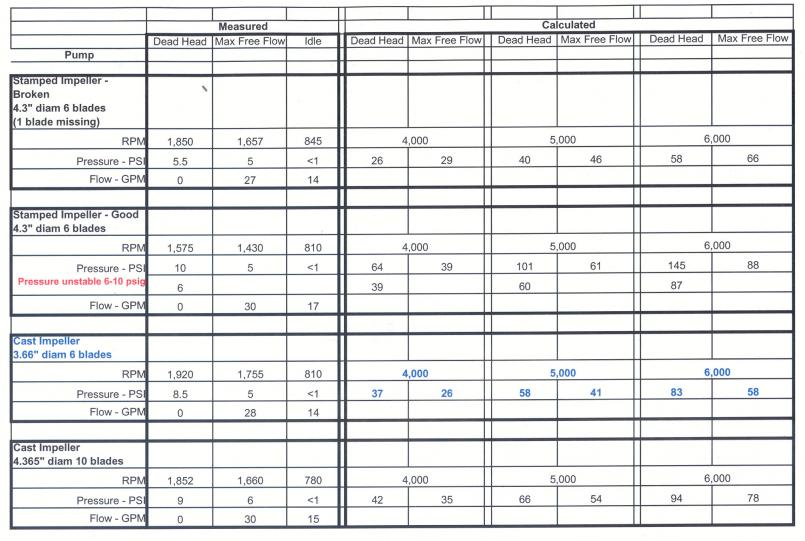 |
Posts in this topic
 nick mironov SBC V8 Water Pump Failure May 6 2010, 12:32 PM
nick mironov SBC V8 Water Pump Failure May 6 2010, 12:32 PM
 messix some else just had this problem less than six mont... May 6 2010, 12:35 PM
messix some else just had this problem less than six mont... May 6 2010, 12:35 PM
 wallys914 You run a Thermostat? I don't... but then agai... May 6 2010, 01:00 PM
wallys914 You run a Thermostat? I don't... but then agai... May 6 2010, 01:00 PM
 Bruce Hinds It's a mopar impeller, they make a few differe... May 6 2010, 01:01 PM
Bruce Hinds It's a mopar impeller, they make a few differe... May 6 2010, 01:01 PM
 zymurgist I drilled a 1/16" hole in the flange of my t-... May 6 2010, 01:43 PM
zymurgist I drilled a 1/16" hole in the flange of my t-... May 6 2010, 01:43 PM
 SLITS It is hard to imagine that a pump would see suffic... May 6 2010, 05:24 PM
SLITS It is hard to imagine that a pump would see suffic... May 6 2010, 05:24 PM
 kg6dxn Buy a Mopar Performance high flow water pump for a... May 6 2010, 06:34 PM
kg6dxn Buy a Mopar Performance high flow water pump for a... May 6 2010, 06:34 PM
 nick mironov This type of failure is a typical problem with th... May 6 2010, 09:07 PM
nick mironov This type of failure is a typical problem with th... May 6 2010, 09:07 PM

 messix
This type of failure is a typical problem with t... May 6 2010, 09:14 PM
messix
This type of failure is a typical problem with t... May 6 2010, 09:14 PM

 kg6dxn
This type of failure is a typical problem with t... May 6 2010, 09:15 PM
kg6dxn
This type of failure is a typical problem with t... May 6 2010, 09:15 PM

 computers4kids
[quote name='nick mironov' post='1314826' date='M... May 6 2010, 10:06 PM
computers4kids
[quote name='nick mironov' post='1314826' date='M... May 6 2010, 10:06 PM
 kg6dxn Found one for you.
http://www.summitracing.com/pa... May 6 2010, 09:22 PM
kg6dxn Found one for you.
http://www.summitracing.com/pa... May 6 2010, 09:22 PM
 messix it's the cavitation that bends the impellers. ... May 6 2010, 09:23 PM
messix it's the cavitation that bends the impellers. ... May 6 2010, 09:23 PM
 kg6dxn Here's a marine version.
http://marineenginep... May 6 2010, 09:35 PM
kg6dxn Here's a marine version.
http://marineenginep... May 6 2010, 09:35 PM
 TC 914-8 Yep I was one of those recient failures.
I went ... May 6 2010, 11:44 PM
TC 914-8 Yep I was one of those recient failures.
I went ... May 6 2010, 11:44 PM

 messix
Yep I was one of those recient failures.
I went... May 7 2010, 08:43 AM
messix
Yep I was one of those recient failures.
I went... May 7 2010, 08:43 AM
 nick mironov That failure looks exactly like mine...
The threa... May 6 2010, 11:56 PM
nick mironov That failure looks exactly like mine...
The threa... May 6 2010, 11:56 PM
 jimkelly maybe i will just keep running my stock water pump... May 7 2010, 04:58 AM
jimkelly maybe i will just keep running my stock water pump... May 7 2010, 04:58 AM
 SLITS In the other thread, someone asked what Ford did t... May 7 2010, 07:08 AM
SLITS In the other thread, someone asked what Ford did t... May 7 2010, 07:08 AM
 SLITS Here's the deal. I will send a pump (that was... May 7 2010, 08:56 AM
SLITS Here's the deal. I will send a pump (that was... May 7 2010, 08:56 AM
 nick mironov I will take you up on this. My housing is out of t... May 7 2010, 06:14 PM
nick mironov I will take you up on this. My housing is out of t... May 7 2010, 06:14 PM
 marks914 Just find the right impeller assembly and replace ... May 7 2010, 08:05 PM
marks914 Just find the right impeller assembly and replace ... May 7 2010, 08:05 PM


 BRAVE_HELIOS Love this write-up!!
I am in the market f... Oct 5 2011, 10:03 PM
BRAVE_HELIOS Love this write-up!!
I am in the market f... Oct 5 2011, 10:03 PM

 BRAVE_HELIOS
[b]This is the Test Setup.
Although the pump ho... Nov 1 2010, 01:46 PM
BRAVE_HELIOS
[b]This is the Test Setup.
Although the pump ho... Nov 1 2010, 01:46 PM
 kg6dxn Very nice. Thanks for doing the research for our b... May 26 2010, 03:29 PM
kg6dxn Very nice. Thanks for doing the research for our b... May 26 2010, 03:29 PM
 TC 914-8 Great write up, details and data.
When I was look... May 26 2010, 11:29 PM
TC 914-8 Great write up, details and data.
When I was look... May 26 2010, 11:29 PM
 drive-ability I had a similar problem, I looked around and found... May 27 2010, 07:38 AM
drive-ability I had a similar problem, I looked around and found... May 27 2010, 07:38 AM
 LvSteveH This is Scott using Steve's 914 World account ... Jun 1 2010, 04:47 PM
LvSteveH This is Scott using Steve's 914 World account ... Jun 1 2010, 04:47 PM

 nick mironov I purchased Scott's / Renegade's bypass th... Jun 2 2010, 01:02 AM
nick mironov I purchased Scott's / Renegade's bypass th... Jun 2 2010, 01:02 AM
 SLITS Ok, last bit of information I will post on this.
... Jun 2 2010, 01:50 PM
SLITS Ok, last bit of information I will post on this.
... Jun 2 2010, 01:50 PM
 nick mironov The Renegade system thermostat with bypass is now ... Jun 6 2010, 10:54 AM
nick mironov The Renegade system thermostat with bypass is now ... Jun 6 2010, 10:54 AM
 nick mironov RE: SBC V8 Water Pump Failure Jun 6 2010, 10:55 AM
nick mironov RE: SBC V8 Water Pump Failure Jun 6 2010, 10:55 AM
 nick mironov RE: SBC V8 Water Pump Failure Jun 6 2010, 10:55 AM
nick mironov RE: SBC V8 Water Pump Failure Jun 6 2010, 10:55 AM
 nick mironov RE: SBC V8 Water Pump Failure Jun 6 2010, 10:56 AM
nick mironov RE: SBC V8 Water Pump Failure Jun 6 2010, 10:56 AM
 nick mironov The only problem I had was that the Renegade ... Jun 6 2010, 10:58 AM
nick mironov The only problem I had was that the Renegade ... Jun 6 2010, 10:58 AM
 nick mironov RE: SBC V8 Water Pump Failure Jun 6 2010, 10:59 AM
nick mironov RE: SBC V8 Water Pump Failure Jun 6 2010, 10:59 AM
 PRS914-6 First let me say that I have never done a SBC conv... Jun 6 2010, 04:49 PM
PRS914-6 First let me say that I have never done a SBC conv... Jun 6 2010, 04:49 PM  |
1 User(s) are reading this topic (1 Guests and 0 Anonymous Users)
0 Members:

|
Lo-Fi Version | Time is now: 3rd April 2025 - 01:08 PM |
Invision Power Board
v9.1.4 © 2025 IPS, Inc.







